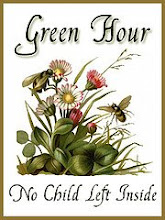 Photocredit:NZEcoWorrier
Photocredit:NZEcoWorrierI still have so much to write about stories and literacy, but I have been desperate to write about sand play since EcoWorrier sent me this photo, of her son in his pyjamas in the Playcentre sandpit.
You’ll find sand play pretty much everywhere in ECE – Playcentres usually have enormous sandpits, and Waldorf/Steiner kindergartens see sand play as essential. In Montessori pre-schools it will be set up for ‘free play time’ and sand trays are often set up for children to practice writing. And of course, playing at the beach should be part of every childs' summer memories.
The nature and value of sand play
‘To very young children the simple delight of rolling in dry sand, pouring it over themselves or burying themselves in it provides an all-over sensory satifsfaction” Gwen Somerset, Vital Play in Early Childhood
I have yet to meet a child who doesn’t love playing with sand, even ‘mess-phobes’ enjoy it (even if the mothers aren’t so keen!).
The youngest toddlers love the tactile experience of sand … the feel of it between fingers and toes, the way wet sand drips off their hands, the way it sticks to everything, the way it can be dug to make a hole, or mounded up into a pile, or poured out of a bucket (And yes, they will even try to eat the stuff!).
As children get older, the sandpit becomes a stage for imaginative play .. so you will see kids making pretend birthday cakes with twig candles, or creating a maze of sand-house villages, or digging trenches for cars to drive through. Other children will see sand as an artistic material for creating intricate sand sculptures and collages.
The value of sand play is immense. As a natural material, sand is an ideal way to learn about hot and cold, wet and dry. It is a first stage of science to see the changes sand goes through from so dry it can easily be sifted, to wet enough to hold its shape, to sopping wet and able to be poured like concrete. Playing with sand develops hand eye co-ordination and fine motor skills ... and it provides great stimulation for imaginative play and artistic creation. They say everything you need to learn can be learned at kindergarten … perhaps in fact it can be learned in the sand pit.
Setting up for sand play
‘No back yard is complete without sand and water. When we think of sand, we want to think big, and lots of it’ Sharifa Oppenheimer, Heaven on Earth
Sand is a relatively easy thing to set up at home. In New Zealand, you’ll often see the large plastic clam shells filled with sand on the front deck. These are easy to set up - a couple of bags of sand from a landscaping supplies depot and you are done. The downside is that there is nowhere for the water to drain, so they fill up and get gloopy. Also, they are pretty small for more than one child … so they don’t really facilitate the kind of ‘sand work’ that pre-schoolers like to get into.
So, if you possibly can, go for ‘big, and lots of it’! You’ll want to make sure its open at the bottom so your kids can ‘dig all the way to China’ … and so the water can drain away keeping the sand fresh. (You’ll also want a good quality cover so the local cats don’t mistake it for a litter box).
Sand is not a lot of fun without water, and Oppenheimer suggests the water source is put “far away from the sandbox to encourage plenty of running ... running back and forth, bucket in hand, is full of meaning and purpose for your child as is creating great river systems in the sandbox’.
Sand play ‘accessories’
Toys for the sandpit are everywhere … any plastic household item is likely to be great. From sad experience, I can say that metal and wood will have a hard life in the sandpit … even our Waldorf/Steiner kindergarten uses plastic materials in the sandpit!
- tupperware containers that have lost their lids, or lids that have lost their containers
- ladles, slotted spoons, salad servers, tongs, scoops, fish slices
- colanders, funnels and steamer baskets
- microwave cooking equipment like those funny egg cookers and muffin trays
- tubes and half-tubes of all shapes and sizes – clean drainage pipe is great, but cardboard postage tubes will last at least a few days unless they get dunked in the water
Natural resources are great for sand play – so collect up things like leaves, twigs, rocks, shells, pebbles, flax fronds, seed pods, acorns, feathers etc. (these natural materials are wonderful for all sorts of open-ended play).
Gwen Somerset (grand-matriarch of the Playcentre movement) says that sand play ‘accessories should be of at least three types:
1) for filling, measuring, pouring – buckets, containers of graded sizes:
2) for carrying or working as adults – large lorries, trucks of different sizes, wood off cuts, vehicles and small cars for roads etc
3) for shaping, digging tunneling – scoops trowels, shovels paua shells and in addition oddments for decoration
Extending sand play
There are just so many ways to extend sand-play. Those of you involved with Playcentre have probably done most of these … but I thought I would list them here anyway!
Set up a sandpit ‘volcano’. In a plastic milk container put 1 cup of baking soda, and some food colouring or tempera powder. Pack up the sand around it in a ‘volcano’ with the top of the milk container exposed. Then, when the kids are ready … pour in a cup of white vinegar and watch it bubble over.
When there are enough adults for supervision, set up a mini bonfire in the sand pit. Roast marshmallows or put pre-baked potatoes in foil at the bottom of the fire to get all smoky and delicious.
Put a paddling pool in the sandpit with a sun umbrella for a beach party. Don’t forget to make some pretty drinks with those little umbrellas and floating cherries.
For dinosaur obsessed 4 year olds create a dinosaur excavation. Bury a range of plastic dinosaur toys, and maybe any 'bones' you can find in the sand. I have heard the idea of partly covering the dinosaurs in plaster of paris, letting them set, and then getting the kids to find them and then ‘dig them out’ … I haven’t tried this one myself but would love to hear how it works!
Messy play … in a bucket put too much water in some sand and then drip it off your fingers - it looks really freaky.
So, tell me what your favourite ideas for sand play are!






10 comments:
Isn't Sharifa Oppenheimer's book wonderful? One of the things she mentions that I've been wanting to do, but haven't yet, is to set up an indoor tub for sand play. From experience with our Montessori sand tray, I know it can be messy. However, it's easy to sweep off our hardwood floors, and that is just another practical life area for Layla to practice. I am loving all your posts on play too. Like you, we are not purists in any one method. Our philosophy is a kind of Charlotte Mason-Waldorf with a bit of Montessori hybrid.
I love you extended sand play ideas. We'll have to try them before the weather gets to cold here. That picture is my worst nightmare and I think my husband would probably faint! ;)
We just love playing in the sand ~ I even find myself running my fingers through it while I'm watching the kids dig and build in it. It's quite a calming effect. x
We got some neat sandpit accessories...when we were clearing out my nana's house there was heaps of old silverware that was in a terrible state including little cooking utensils (kind of funny to think of the family silver in the sandpit lol), little stainless steel teapots, bowls and saucepans, chunky ceramic eggcups etc. I reckon a visit to an op-shop for these types of things would give a cool organic type look to any sandpit and are "real" too.
Our sandpit also has a couple of little old wooden picnic bench/seats alongside it for working at - becomes the kitchen or place to easily stand at.
I can't tell you the pleasure that photo gave me! I think sand is my favourite area of play, even though I am there less than I would like nowadays while my baby is small.
I'll have to disagree with you though about metal and wood in the sandpit. Certainly, water is not kind to wood and metal! And there are many interesting plastic sand toys available. But one thing about Playcentre is that we are supposed to use real tools and the right tools. Big kids digging big holes, trenches and canals need real spades - metal heads, wooden handles. Plastic ones are far less satisfying.
Large sit-on wooden diggers and cranes can also be enormously popular and enduring - there's one hiding in the background of the photo. (I guess that's covered in the second point in the quote from Gwen Somerset).
I asked at the Steiner kindy I visited about their plastic in the sandpit, and they said they had got rid of the wood and metal spades for safety reasons. Perhaps the adult-child ratios at Playcentre also help here??
We've also got some old wooden unit blocks that are for outdoor use. A year or so ago I tried to find out how old they were - no-one knew as they were already there 10 years ago (and may have been quite a bit older as they are based on imperial measurements). So even wood can survive a hard life in sand and water.
In terms of extensions, and linking this with your last post - last week we were writing children's names in wet sand with our fingers.
I'm really enjoying this series - so pleased to see you blogging again.
Thanks for your comments everyone!
Melissa - yes I am keen to do an indoor sand play - I thought about getting a kitty litter box from the supermarket (we don't have a cat so i think we are safe!) but I know what a mess it would turn into, and I'm not as game as you for that particular PL 'work'!!! For anyone interested in "Creative Play for your Baby' by Christopher Clouder there are great ideas for an indoor sand box!
Nikki - great idea about the opshop, I bet there are great things in there!
Mary - I think we've discovered an area where PC is more Steiner than Steiner. I think you are right about the high parent ratios helping with that. I am sure that if I was vigilant about taking sand toys out, cleaning them off and storing them properly then wood and metal would be more of an option! Thanks for the challenge on this - I always appreciate the time you take to write insightful comments :)
I read your post about imitation-very informative and well said. I appreciate your blog and the way you share your knowledge of children and development. There is a lot for a parent or caregiver to think about when we consider the significance of working with children and it's lifelong impact. About this post- I am excited (and nervous) to set up an indoor sand box soon in our home. It will be perfect for winter and I know my daughters will love it- I am just hoping they are up to following the guidelines that come along with it!
Thanks Amy - and looking at the wonderful Montessori structure you have with your kids I'm sure you'll be able to set up an indoor sand box with no trouble :)
a lovely post!
i find it so important for children to truly delve right in to their environment... i.e. getting messy, playing in the mud, the wet sand all of it is a positive sensory experience and a way for them to truly 'understand' the elements not just by seeing them, reading about them but being one with them. The same goes for the weather, play in the rain the snow the wind is a perfect way to understand and really appreciate the weather. We are blessed to live in a wide open natural space so our sand play play is in the sand along the rivers and lakes. In the winter time we bring in trays of sand and have added (as you mentioned) different natural things into it for discovery. We do this with the snow as well when the temps dip way below we fill the kitchen sink with lots of snow and add kitchen utensils. It is incredible the time spent in this type of play.
When we were at the beach on the weekend the 8 month old ate a lot of sand! Gorgeous ideas, thanks for sharing them (and for voting too!).
Post a Comment